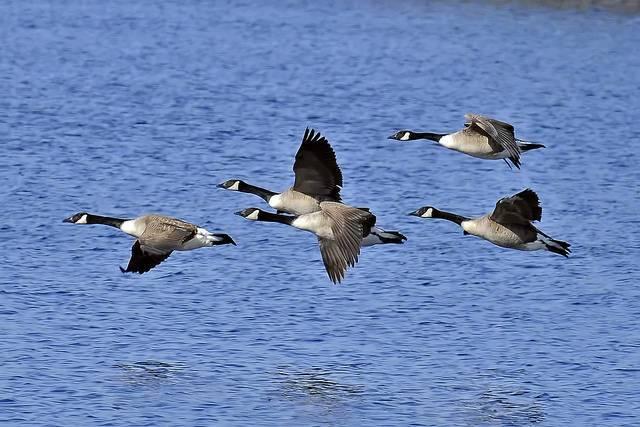
According to a recent report on Bloomberg, Boeing Co. and NASA believe they have discovered a way to improve airplanes’ fuel efficiency with a slight biomimicry twist: copy birds’ flight formations, such as those taken by Canada geese.
By using navigation and collision-avoidance technology, jetliners could fly routes across the country in V-shaped formations. This technique, wake surfing, would allow planes flying near each other to align in just the right spot, which would reduce drag and therefore, fuel consumption. The approach is one similar to what the Canada geese and other migratory birds adopt when they travel for long distances. In the case of these birds, each individual goose takes advantage of the air coming from the one flying in front of it. When the bird leading the flock becomes tired, it simply moves to the back, and the next one in line takes its turn leading the formation.
NASA has been studying ways to mimic birds in nature for years in order to fly more efficiently within the earth’s atmosphere and in outer space. The aviation agency and Boeing have also partnered on researching many other initiatives, from redesigning airplane wings in order to conserve fuel, as well as eliminating the “sonic boom” that long ago stalled the progress of advanced commercial aircraft such as the Concorde.
Both the U.S. federal government and aircraft manufacturers such as Boeing have plenty of reasons to explore how flying could become more efficient. A recent United Nations report estimated that international air travel over the next few decades will surge to the point that emissions from air travel could comprise one-quarter of the world’s carbon footprint by 2050 if left unchecked.
It will be a while, however, before we start seeing planes migrate like birds moving south. First, the low cost of fossil fuels has helped airlines glide through a record span of profitability. Federal regulations also require minimum spacing between planes, so a recalcitrant Congress would have to follow the lead of agencies that have long comfortable with their safety guidelines. And as Bloomberg’s Julie Johnsson also points out, that surge in scheduling and airplane arrivals face other challenges: managing employee work schedules, sudden bad weather, maintenance schedules and notoriously bad U.S. air traffic congestion.
Nevertheless, advances in technology could help transform the aviation sector as it weans itself away from being managed by 20th-century tools. And NASA has science on its side – as in a study conducted early this century that found when F-18 fighter jets flew in a bird-like formation, they achieved fuel savings of at least 15 percent.
Image credit: Nature Framingham/Flickr

Leon Kaye has written for 3p since 2010 and become executive editor in 2018. His previous work includes writing for the Guardian as well as other online and print publications. In addition, he's worked in sales executive roles within technology and financial research companies, as well as for a public relations firm, for which he consulted with one of the globe’s leading sustainability initiatives. Currently living in Central California, he’s traveled to 70-plus countries and has lived and worked in South Korea, the United Arab Emirates and Uruguay.
Leon’s an alum of Fresno State, the University of Maryland, Baltimore County and the University of Southern California's Marshall Business School. He enjoys traveling abroad as well as exploring California’s Central Coast and the Sierra Nevadas.














